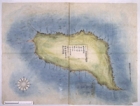Japanese Gallery (Honkan) Room 16
November 13, 2007 (Tue) - December 16, 2007 (Sun)
Hokkaido, the name of the large island in northern Japan, was designated on August 15th 1869. During the Edo period (1603-1869), the region was known as Ezo.
The Shogunate sent research teams to Ezo from the end of the 18th century. The teams conducted investigations to Ezo to understand how people lived, survey the land, and maintain Japan's borders. Hokkaido's history is intertwined with the Ainu, an indigenous population with different culture and customs than the Japanese. People throughout Japan were able to learn about Ezo by reading the reports and books written by members of the investigation teams.
This exhibition highlights how Ezo was understood at the time and the relationship between the Ainu and the only daimyo fief, Matsumae. Included are maps by Imai Hachikuro, a retainer from Matsumae, a travelogue by explorer Matsuura Takeshiro, and items the Ainu received by trading with continental Asia.
We hope that this exhibition is informative and reveals new insights about Hokkaido and its history.

